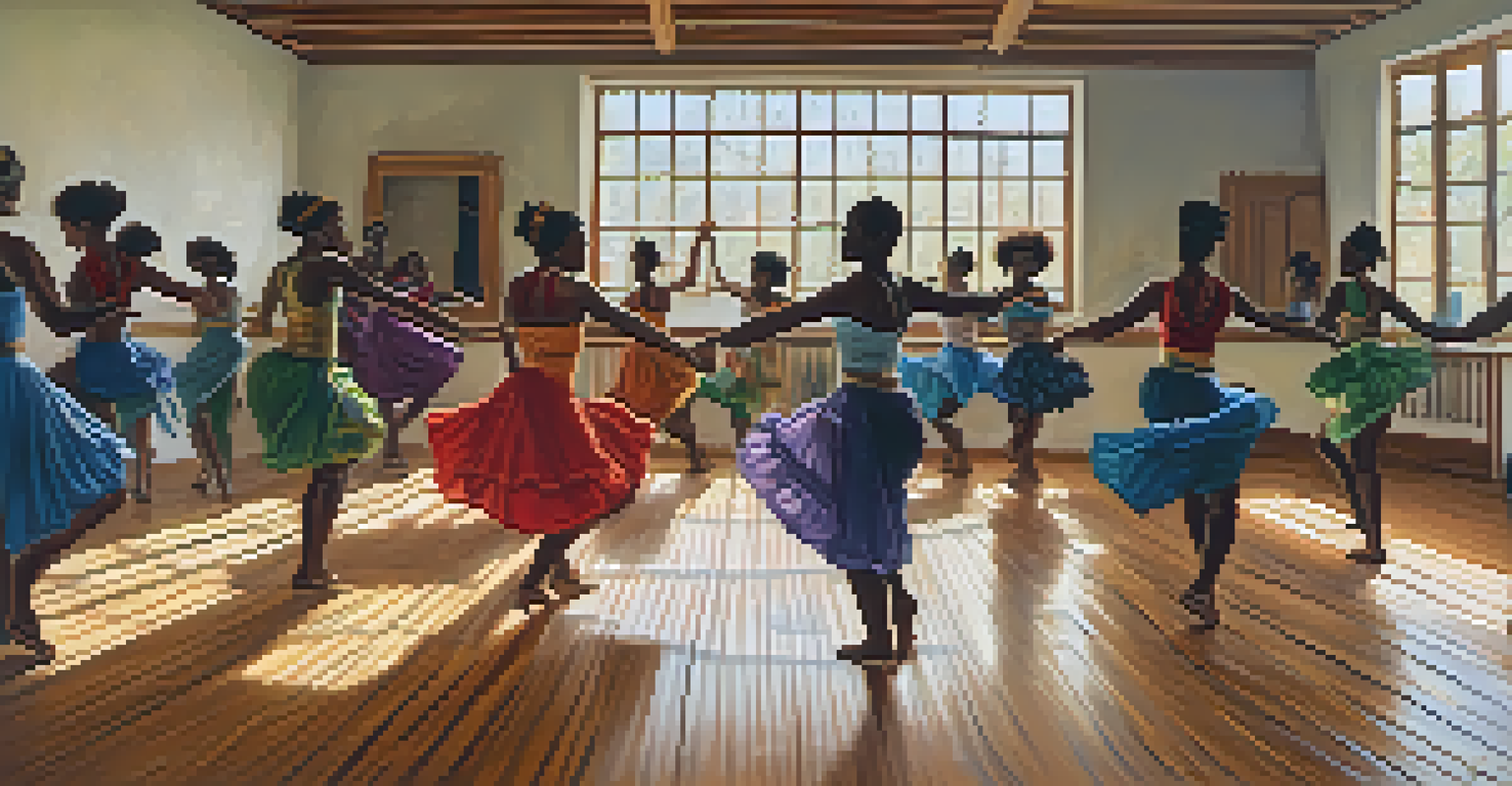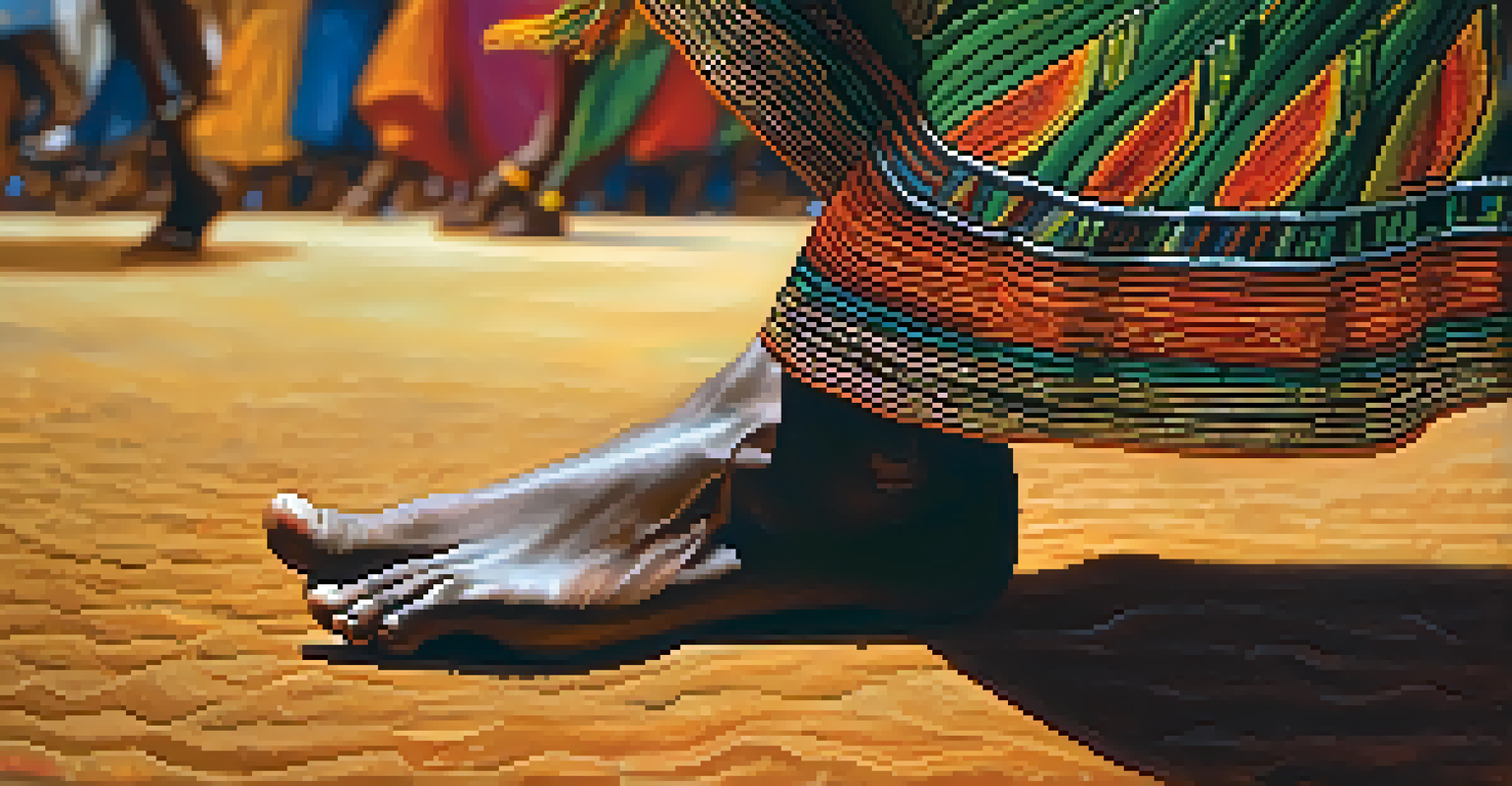Influence of African Dance on Western Dance Forms

The Roots of African Dance: A Cultural Heritage
African dance is more than just a performance; it's a reflection of culture and community. Each movement tells a story, often linked to rituals, ceremonies, and celebrations. The vibrant rhythms and expressive gestures serve as a means of communication and connection among people, emphasizing the importance of community in African societies.
Dance is the hidden language of the soul.
These dances often incorporate elements like call and response, where the audience actively participates, fostering a sense of togetherness. This interactive style contrasts with the more formal, solitary performances typical in Western dance. Understanding these roots is crucial to appreciating how African dance has influenced various Western styles.
As African dance began to spread across the globe, it carried with it the rich traditions and narratives that have shaped countless forms of expression. From social gatherings to theatrical performances, the essence of African dance is woven into the fabric of modern dance, showcasing its enduring legacy.
Key Elements of African Dance That Inspire Western Styles
One of the most notable aspects of African dance is its rhythmic complexity. Dancers often use polyrhythms, where multiple rhythms are layered together, creating a dynamic and engaging experience. This technique has found its way into various Western dance forms, particularly in genres like jazz and hip-hop, where rhythm plays a central role.

Additionally, the use of body isolations and grounded movements in African dance emphasizes the connection to the earth, contrasting with the elevated, airy movements often seen in ballet. This grounding aspect has influenced contemporary dance, encouraging dancers to explore their physicality in new and innovative ways.
African Dance Reflects Culture
African dance serves as a vital expression of community, rituals, and cultural narratives, emphasizing connection among people.
Moreover, the expressive use of the torso and the importance of improvisation in African dance have encouraged Western dancers to break free from traditional forms. This blending of styles creates a rich tapestry of movement that speaks to the diversity and evolution of dance as an art form.
African Dance in the Evolution of Jazz and Contemporary Dance
Jazz dance, with its roots deeply embedded in African American culture, showcases the direct influence of African dance traditions. The improvisational aspects of jazz mirror the spontaneous nature of African performances, where dancers express themselves freely, often responding to the music and the audience.
The body says what words cannot.
As jazz evolved, it incorporated elements like syncopation and body movement that are hallmarks of African dance. This integration not only enriched jazz but also paved the way for various dance forms, including tap and modern dance. The rhythmic footwork and energetic movements reflect the vibrant spirit of African dance.
Contemporary dance has also embraced these influences, often blending various styles to create unique performances. Choreographers draw inspiration from African dance to explore themes of identity, culture, and community, showcasing the genre's profound impact on the evolution of dance in the Western world.
The Role of African Dance in Popular Culture and Media
African dance has made significant inroads into popular culture, often featured in films, music videos, and dance competitions. Artists like Beyoncé and Usher incorporate African-inspired movements into their choreography, highlighting the genre's influence on contemporary music and performance.
Television shows like 'So You Think You Can Dance' and 'Dancing with the Stars' showcase a variety of dance styles, often including African dance forms. This exposure not only educates audiences about the richness of African dance but also promotes its integration into mainstream culture.
Influence on Western Dance Styles
The rhythmic complexity and improvisational aspects of African dance have significantly shaped genres like jazz and contemporary dance.
Moreover, dance studios and schools are increasingly offering classes in African dance, allowing new generations to experience its power and beauty. This growing appreciation for African dance contributes to a broader understanding of its significance in the global dance landscape.
Cultural Appropriation vs. Cultural Appreciation in Dance
As African dance influences Western forms, discussions around cultural appropriation and appreciation have emerged. It's essential to recognize the origins and significance of these movements while also celebrating their evolution in new contexts. Understanding the difference between appropriation—taking elements without understanding their meaning—and appreciation—honoring and respecting the original culture—is crucial.
In dance, this means acknowledging the roots of African movements while giving credit to their cultural significance. Collaborations between African and Western dancers can foster mutual respect and understanding, creating a platform for dialogue and exchange.
By promoting cultural appreciation, dancers can honor the rich traditions of African dance while exploring its influence on their own art forms. This approach not only enriches the dance community but also ensures that the voices and stories of African cultures are respected and celebrated.
The Future of African Dance in Western Dance Forms
The ongoing dialogue between African and Western dance traditions is likely to continue evolving. As more dancers and choreographers engage with African dance, we can expect to see further innovations that blend these rich histories. This fusion will not only create new dance forms but also foster a deeper understanding of cultural narratives and expressions.
Workshops, festivals, and collaborations are essential for keeping the dialogue alive. These gatherings create opportunities for dancers from different backgrounds to learn from one another, share techniques, and innovate together. Such interactions enrich the global dance community and help preserve the integrity of African dance.
Cultural Appreciation in Dance
It's essential to distinguish between cultural appropriation and appreciation, honoring the roots of African dance while celebrating its evolution in Western forms.
As we look to the future, it's clear that African dance will remain a vital source of inspiration for Western styles. By embracing this influence, dancers can continue to explore new creative avenues while honoring the powerful legacies of African movement traditions.
Celebrating the Richness of African Dance and Its Impact
Celebrating the influence of African dance on Western forms is essential to appreciating the diversity of global dance. Its vibrant rhythms, expressive movements, and cultural significance have enriched various styles and created a more inclusive dance landscape. Recognizing this influence allows us to honor the roots of dance while embracing its evolution.
Dance is a universal language that transcends cultural boundaries, and the integration of African dance into Western forms exemplifies this connection. By sharing stories and experiences through movement, dancers can foster a sense of unity and understanding across cultures.

Ultimately, the journey of African dance in the Western world is a testament to the power of art to inspire, connect, and transform. As we celebrate this beautiful fusion, we also pave the way for future generations to explore, innovate, and continue this vibrant dialogue.